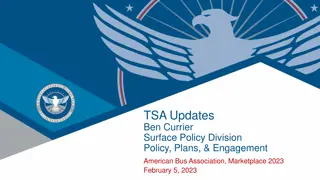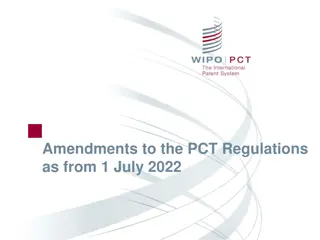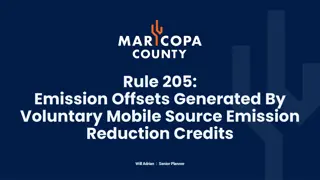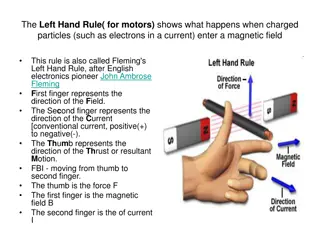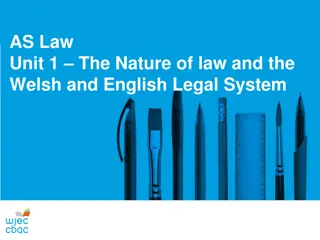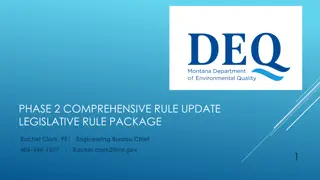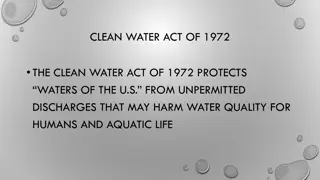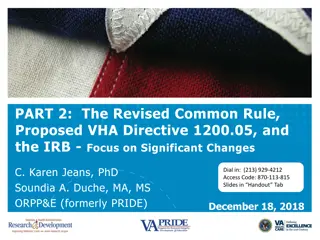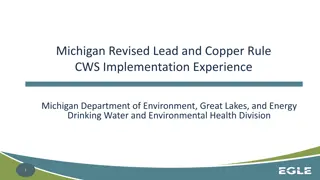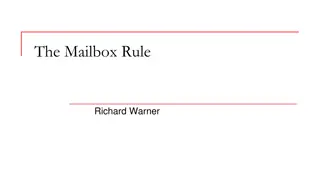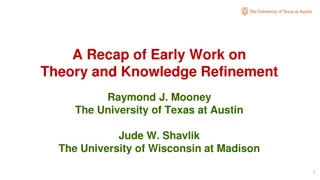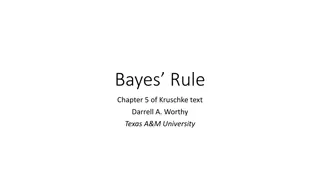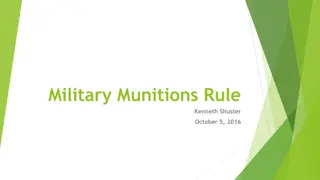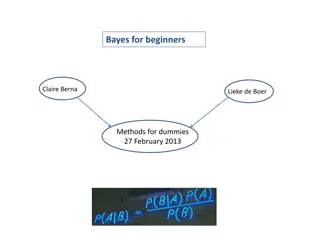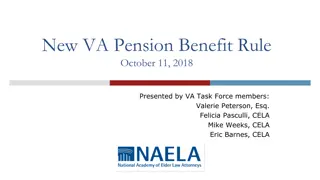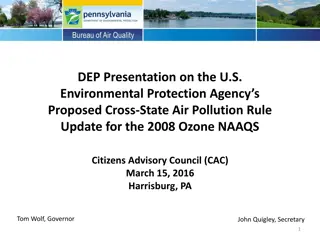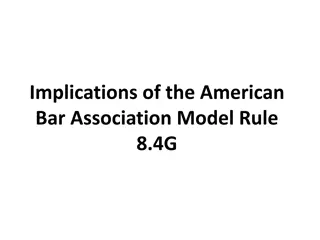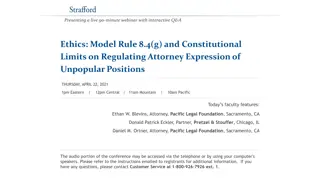Understanding the Impact of the Updated WOTUS Rule
The presentation delves into the significance of the new WOTUS rule under the Federal Clean Water Act, its implications for Michigan businesses like aggregate miners, and the historical context leading to this point. It discusses the regulatory authority provided by the definition of WOTUS, the impact on permitting programs, and the key components of the 1993 WOTUS definitions. Overall, it sheds light on why the new rule is important and the potential effects on various regulatory programs.
Download Presentation

Please find below an Image/Link to download the presentation.
The content on the website is provided AS IS for your information and personal use only. It may not be sold, licensed, or shared on other websites without obtaining consent from the author. Download presentation by click this link. If you encounter any issues during the download, it is possible that the publisher has removed the file from their server.
E N D
Presentation Transcript
Waters of the United States Update Dennis J. Donohue Michigan Aggregates Association Annual Meeting February 5, 2020 1
Presentation Summary Why is this new rule important? How did we get to this point? What does the new rule mean for aggregate miners and other Michigan businesses?
Why the New Rule is Important The Federal Clean Water Act ( CWA ) regulates discharges of pollutants to Waters of the United States ( WOTUS ). CWA Section 402 (NPDES program) CWA Section 404 (dredge and fill program) The definition of WOTUS, therefore, defines the scope of the CWA Definition of WOTUS also impacts (but does not necessarily define) the scope of state laws providing the basis of CWA regulatory authority that has been assumed by states like Michigan. Part 31 of the Natural Resources and Environmental Protection Act ( NREPA ) (CWA 402 NPDES Program) Part 301 and Part 303 of NREPA (CWA 404 program)
Why the New Rule is Important (Contd) The new WOTUS rule will probably have a limited, if any, impact on the CWA 402/Part 31 NPDES permitting program. The new WOTUS rule will have a substantial impact on the CWA 404 permitting program nationally. It will also impact Michigan s Part 301/303 wetlands permitting program, but in a more limited way.
How Did We Get to This Point? 1993 WOTUS Definitions (40 CFR 122.2 (EPA) 33 CFR 328.3 (USACE)): All waters which are currently used, were used in the past, or may be susceptible to use in interstate or foreign commerce, including all waters which are subject to the ebb and flow of the tide (i.e. traditionally navigable waters). All interstate waters, including interstate wetlands. All other waters such as intrastate lakes, rivers, streams (including intermittent streams), mudflats, sandflats, wetlands, sloughs, prairie potholes, wet meadows, playa lakes, or natural ponds the use, degradation, or destruction of which would affect or could affect interstate or foreign commerce including any waters: Which are or could be used by interstate and foreign travelers for recreational or other purposes From which fish or shell fish are or could be taken and sold in interstate or foreign commerce Which are or could be used for industrial purposes by industries in interstate commerce (migratory bird rule )
How Did We Get to This Point? (Contd) 1993 Rule Cont d: All impoundments of waters otherwise defined as waters of the United States under this definition. Tributaries of waters identified above. The territorial seas. Wetlands adjacent to waters identified above.
How Did We Get to This Point? (Contd) The Supreme Court weighs in: 2001 SWANCC Decision (voids migratory bid rule ) 2006 Rapanos Decision Plurality (Scalia) said CWA applies only to relatively permanent, standing, or continuously flowing waters and wetlands with a continuous surface connection to such waters. Concurring opinion (Kennedy) said remote waters and wetlands with a significant nexus to the traditional waters of United States are within the scope of CWA.
How Did We Get to This Point? (Contd) 2008 Agency Guidance: CWA jurisdiction exists over a water body if either the plurality s or Justice Kennedy s standard is satisfied. 2015 WOTUS Rule: Created three categories of waters: Waters that are covered in all instances without need of site-specific analysis. Waters subject to site-specific analysis to determine whether they are jurisdictional. Waters specifically excluded from regulations. Based heavily on scientific conductivity study by EPA.
How Did We Get to This Point? (Contd) 2015 Rule: Waters that are covered in all instances without the need for site specific analysis included traditionally navigable waters, interstate waters and wetlands, territorial seas, and impoundments of these waters. In addition, tributaries to these waters and all waters and wetlands adjacent to these waters and their tributaries also automatically covered. Tributary defined very broadly to include any feature with bed, banks and indications of an ordinary high water mark ( OHWM ) (can be ephemeral or intermittent). Adjacent also broadly defined, and includes any wetlands within 100 year flood plain of any water or tributary described above and/or within 1,500 feet of the OHWM of these waters.
How Did We Get to This Point? (Contd) Waters covered on a site specific basis include: prairie potholes (glacially formed wetlands), and other types of wetlands found in different parts of the country if they have a significant nexus to waters automatically covered. wetlands within a 100 year flood plain or 4000 feet of the OHWM of waters covered automatically if they have a significant nexus to any of the waters covered automatically. Significant nexus defined broadly hydrologic connection not necessary, must look at it from a watershed perspective. Excluded waters included some ditches (so long as they don t connect to WOTUS) and purely erosional features, as well as water filled depressions created in dry land incidental to mining or construction activity, including pits excavated for obtaining fill, sand or gravel that fill with water.
New WOTUS Rule and Impact on Michigan Trump administration WOTUS Rule Not a simply an opposites day reaction to 2015 Obama administration Rule. WOTUS has been unsettled and controversial for decades. 2020 rule reflects cooperative federalism movement and the idea (supported in caselaw) that application of the outer limits of constitutional commerce clause authority should not be the assumed intention of congress unless congress expressly states such intention. That science, even if sound, can t be used as the basis to obviate constitutional/legal constraints on federal power 12
New WOTUS Rule and Impact on Michigan (Cont d) January 2020 Rule WOTUS Definitions The territorial seas, and waters which are currently used, or were used in the past, or may be susceptible to use in interstate or foreign commerce, including waters which are subject to the ebb and flow of the tide; Tributaries; Lakes, ponds, and impoundments of jurisdictional waters; and Adjacent wetlands. Non-jurisdictional waters. The following are not waters of the United States: Waters or water features that are not identified in paragraphs (1)(1) through (4) of this section; Groundwater, including groundwater drained through subsurface drainage systems; Ephemeral features, including ephemeral streams, swales, gullies, rills, and pools;
New WOTUS Rule and Impact on Michigan (Cont d) Diffuse stormwater run-off and directional sheet flow over upland; Most ditches; Prior converted cropland; Artificially irrigated areas, including fields flooded for agricultural production, that would revert to upland should application of irrigation water to that area cease; Artificial lakes and ponds, including water storage reservoirs and farm, irrigation, stock watering, and log cleaning ponds, constructed or excavated in upland or in non- jurisdictional waters, so long as those artificial lakes and ponds are not impoundments of jurisdictional waters that meet the conditions of paragraph (c)(6); Water-filled depressions constructed or excavated in upland or in non-jurisdictional waters incidental to mining or construction activity, and pits excavated in upland or in non- jurisdictional waters for the purpose of obtaining fill, sand, or gravel;
New WOTUS Rule and Impact on Michigan (Cont d) Stormwater control features constructed or excavated in upland or in non-jurisdictional waters to convey, treat, infiltrate, or store stormwater run-off; Groundwater recharge, water reuse, and wastewater recycling structures, including detention, retention, and infiltration basins and ponds, constructed or excavated in upland or in non-jurisdictional waters; and Waste treatment systems. Significantly rolls back what is covered broad definitions of adjacent, tributary have been eliminated. A tributary must have water flowing in it in a typical year to qualify as a tributary, for example. Much more common sense, streamlined approach.
New WOTUS Rule and Impact on Michigan (Cont d) Michigan s assumed wetlands program is based on Parts 301 and 303 of NREPA. Part 303 currently regulates wetlands contiguous to Great Lakes, Lake St. Clair, or on inland lake, pond, river or stream, plus wetlands not contiguous, but more than 5 acres, or, if less than 5 acres, a wetland that EGLE determines is essential to preserve State s natural resources from pollution, impairment, or destruction. MCL 324.30301(m). Wetlands created incidental to active sand and gravel mining operations excluded. MCL 324.30305(4). Part 301 regulates creation, alteration of and placement of structures in and dredging of inland lakes and streams, which means either a WOTUS or any natural or artificial waterbody with definite banks, bed, and evidence of continuous flow or continued occurrence of water greater than 5 acres. MCL 324.30101(i).
New WOTUS Rule and Impact on Michigan (Cont d) Michigan Parts 301 and 303 tied into Federal WOTUS rule: MCL 324.30328; 324.30101a: For purposes of this part, the powers, duties, functions and responsibilities exercised [by EGLE] because of federal approval of Michigan s [assumed wetland permitting program under CWA Section 404] apply only to navigable waters and Waters of the United States as defined [under the CWA], as further refined by federally promulgated rules and court decisions that have the full force of federal law. Determining whether additional regulation is necessary to protect Michigan waters beyond the scope of federal law is the responsibility of the Michigan legislature. . . . 17
New WOTUS Rule and Impact on Michigan (Cont d) So, does this language limit EGLE authority under Parts 301 and 303 only to the new more restrictive WOTUS Rule? Unclear. EGLE s position will likely be that this language does not reduce the scope of EGLE jurisdiction as of the date of this language was added to the statute in 2013. Thus, the current definitions of wetland and inland lake or stream would still hold. Broader than federal rule. But U.S. EPA s Red File reviews of projects should be greatly constrained however, and EGLE/EPA MOA may need to be revised. Questions? 18




